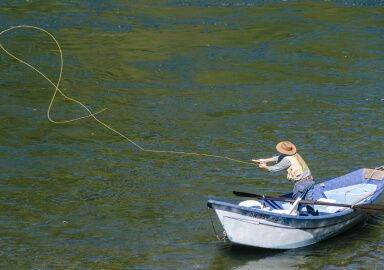Gilt-head Bream
The gilt-head bream is a medium sized, bottom-loving predator of the western European Atlantic Ocean shore.
View 8 listings
8
listings
–
price starting from
4
countries
–
to the nearest trip
Where and When?
Gilt-head bream are found round the eastern European shores from southern United Kingdom, southwards into the Mediterranean and Black Seas. They also extend offshore to the Canary and Cape Verde islands. In the northern, higher rainfall areas, most gilthead are caught fairly close inshore and also in estuaries and lagoons, including in brackish waters. In the southern, usually drier areas, the lucky spots tend to be in fairly shallow waters of about 1 – 30 m (3-98 ft.), but they may also be found down to about 150 m (490 ft.). In the shallower areas gilt-head bream seem to prefer weed-beds and sandy bottoms whilst in the deeper regions they are usually found within a few meters of the bottom. The species may be caught throughout the year, although the fishing is often best, particularly in the northern areas, in June, July and August. Also, in the shallow waters, fishing is usually best early in the day, particularly around dawn, while in deeper waters this is less important.
About Gilt-head Bream
Gilt-head bream (Sparus aurata) have a typical “bream” shape, being laterally compressed with a rounded, sloping “forehead”, down to a smallish mouth full of strong grinding teeth. Their colour is variable but tends to be silverish on the sides, darker near the top and lighter below, with a characteristic clear gold bar between their eyes. The caudal (tail) fin usually has a dark/black margin. Both sexes appear similar, but individuals seem to start as males and then change to active females - a condition known as “protandric hermaphroditism”.
Giltheads are mostly bottom feeders, eating many kinds of invertebrates and the occasional small fish. Favoured foods are mussels, oysters and worms that are ground up by the powerful teeth. While they can attain about 70 cm (27.5 in.) and 7.3 kilograms (16.2 lbs.), most fish caught are in the 33-40 cm (12-16 in.) range. Depending on the area, most fishing is carried out either in estuaries and lagoons, or offshore should these not be present. Gilt-head bream are usually solitary, especially as adults, but they occasionally form small aggregations. They spawn in winter, mostly in October to December, in deep waters.
How to Catch?
The best way to catch gilthead depends on the location. In the north, particularly around southern United Kingdom, much of the fishing is carried out from the shore, or from small boats, in estuaries, harbours and bays. Fairly light tackle is usually used but the species is well known for crushing small hooks and snapping lines that are too light, or if the drag has been set too strongly. The answer is to use high quality hooks and ensure that they are always sharp and be very alert to a “take”, as the gilt-head bream has a reputation of sometimes suddenly grabbing a bait and running hard and fast.
Giltheads mostly eat invertebrates on the bottom and so a sliding weight with a smallish (but strong) hook, cast out to a suitable looking area, is often best. They are very alert and so caution should be used when approaching any fishing area. The best baits to use are usually locally collected fresh crabs, shellfish and worms, but soft plastics can also be used, with great care, to good effect. In the southern areas there are fewer estuaries and most gilt-head bream fishing is carried out from small boats in deeper waters. European marine anglers seem to agree, however, that gilt-head bream are one of the strongest, more difficult to catch but good tasting, fish found along the European shores.







